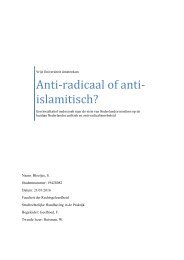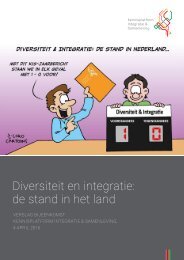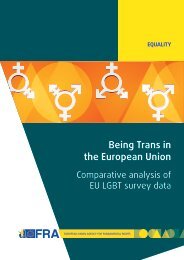Tilburg University Chineseness as a Moving Target Li Jinling
Li_Chineseness_12_09_2016
Li_Chineseness_12_09_2016
Create successful ePaper yourself
Turn your PDF publications into a flip-book with our unique Google optimized e-Paper software.
The changing nature of Chinese di<strong>as</strong>por<strong>as</strong> 15<br />
By 1990, the number of Chinese living outside the PRC and ROC had been<br />
estimated approximately 37 million (Fan, 2003; Poston, Mao & Yu, 1994). Among<br />
them, the majority, 32.3 million, lived in Asia. In non-Asia countries, the United States<br />
(US) h<strong>as</strong> the largest number of Chinese immigrants, making the country the home to<br />
the biggest Chinese community outside of Asia. More recent studies show the number<br />
of Chinese overse<strong>as</strong> incre<strong>as</strong>ing to over 50 million. In the book on the Chinese di<strong>as</strong>pora<br />
edited by Ma and Cartier (2003), scholars working in various parts of the world trace<br />
the Chinese di<strong>as</strong>pora everywhere it had become a significant force, from Southe<strong>as</strong>t Asia<br />
to Oceania, North America, Latin America, and Europe. The authors describe the sharp<br />
difference between sojourning Chinese prior to the 1960s and the transnational<br />
Chinese of the current era. Early Chinese emigration coincides with the turbulent final<br />
days of the Qing dyn<strong>as</strong>ty (1644-1911), the first Sino-Japanese war (1884-1885), and the<br />
1911 Revolution, which made an end to imperial China and turned it into a Republic.<br />
This w<strong>as</strong> a time of extreme civil unrest and disorder and to a large part explains why so<br />
many Chinese with access to the sea were ready to leave their country behind in search<br />
for a better life overse<strong>as</strong>. It predates however, by several generations, the split of China<br />
into two systems <strong>as</strong> an outcome of the Chinese civil war (1927-1948): the People’s<br />
Republic of China ruled by the Chinese Communist Party in Beijing and the Republic of<br />
China ruled by the Chinese Nationalist Party (Kuomintang) in Taipei on the Island of<br />
Taiwan.<br />
In the US, California h<strong>as</strong> the largest number of Chinese di<strong>as</strong>por<strong>as</strong>, and the San<br />
Francisco Bay Area, along with the Los Angeles and New York metropolitan are<strong>as</strong>, have<br />
one of the highest urban concentrations of Chinese in the country. <strong>Li</strong> Wei (1998, 1999)<br />
conducted research in the San Gabriel Valley in Los Angeles. On the b<strong>as</strong>is of historical<br />
records, census data, and interviews, she showed how the Chinese community within<br />
this region in particular, h<strong>as</strong> evolved from densely populated downtown Chinatowns to<br />
more geographically spread out regions in an ethnic suburb. <strong>Li</strong> Wei argues that the<br />
Chinese ethnic suburbs originated from the new immigrants’ desire for suburban living<br />
and have taken on a new ‘global economy outpost’ function, by serving residential and<br />
services needs of new immigrants whose economic and social networks are more<br />
international in scope than those of the older immigrants. According to <strong>Li</strong> Wei<br />
(1999:18), ‘the San Gabriel Valley ethnoburb had become by 1990 a more important<br />
Chinese residential area than Chinatown.’ She explains how the ethnoburb offers more<br />
opportunities when compared to a Chinatown, <strong>as</strong> there are additional economic<br />
benefits through business opportunities when catering towards the regional cultural<br />
identity. She further shows differences between an ethnoburb and Chinatown in that<br />
the composition of the populations varies in terms of age, socioeconomic level, and<br />
time since their immigration. Within a Chinatown, the population is mainly<br />
‘immigrants of Chinese descendants from mainland China and Southe<strong>as</strong>t Asia, with a<br />
much older age structure and longer duration of residence… [and] the socio-economic<br />
status of its residents is lower’ (<strong>Li</strong> Wei, 1999:21). In contr<strong>as</strong>t, although culturally an<br />
ethnoburb may appear to cater towards a specific ethnic group, these regional are<strong>as</strong><br />
tend to include a more ethnically diverse population which is composed of a greater<br />
variety of age groups with a higher socioeconomic status. In addition, a higher level of<br />
education is more common within an ethnoburb when compared to a Chinatown, thus









